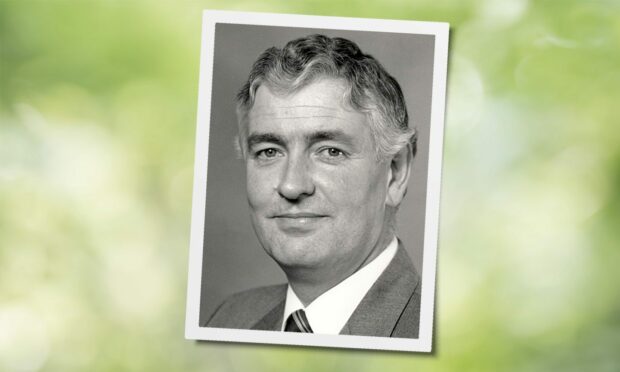While Sir Ian Grant, who has died aged 79, stood out as one of the most impressive farming leaders of the past century, he also uniquely steered to success a wide range of non-farming bodies and companies who valued and benefitted from his business and leadership skills.
Brought up on the family farm in Perthshire, Sir Ian was schooled at Strathallan and afterwards at Edinburgh College of Agriculture before returning home to Thorn, near Alyth, where one of the main enterprises was producing commercial cattle.
In his early days in farming Ian followed his father in picking up top awards for his livestock.
Livestock judge
He was also known as a good judge of stock and soon was involved in prestigious events such as the Scottish Winter Fair and the Royal Smithfield Show. He became the chief cattle steward in London at a time when it was the premier country-comes-to-town event in the country.
In his early days, he was also a director of the farm cooperative, East of Scotland Farmers, a business noted for its financial acumen.
He retained this directorship for more than two decades. Later in life and following his belief in cooperation in farming, he served in the European farm cooperative movement as chairman of the Copa Cereals Group in Brussels.
At home after schooling, he quickly became involved within the National Farmers Union of Scotland, initially with the Perth branch.
International brief
Very soon afterwards he was invited to sit on national committees and then, in short order, to represent his country on various committees in Brussels where he dealt with the Common Agricultural Policy for the European Community.
In 1984 he was appointed president of NFU Scotland as the leading person in the then 20,000-member strong organisation.
This was a period of considerable unrest in agriculture with turmoil between the various EU members over the Common Agricultural Policy.
It was also a time when he had to deal with protests by farmers but his diplomacy gained him a reputation which saw him become a major figure on committees in Brussels, including chairing the International Federation of Agricultural Producers, a worldwide organisation at that time with 600 million members.
Nuclear fallout
During his time as NFUS president he dealt with a number of challenges including the infamous Edwina Currie interview which had ramifications for the poultry industry, several calamitous spells of weather in Scotland and the Chernobyl disaster.
Prevailing winds had carried radioactive Caesium 137 from the reactor site and deposits were discovered in grazing land in parts of the UK, including Scotland.
Frantic discussions with Government led to restrictions on the sale and slaughter of lambs from those areas and a testing regime and compensation package for farmers was agreed.
Sir Ian’s negotiation skills were rapidly being recognised outwith agriculture and he was soon asked to take on further responsibilities.
Tourism advocate
As the leader of a representational organisation Sir Ian believed he should remain totally impartial and rejected other approaches until the end of his tenure in 1990 when he agreed to join the Scottish Tourist Board as its chairman.
He enthusiastically led many missions in the UK and around the world to put Scotland on the international map as an attractive destination for visitors.
In 1993, Sir Ian sold the farm to concentrate fully on other responsibilities and the Grant family moved into Alyth.
His charisma, dedication, interest in people and ability to get to the heart of an issue meant other appointments came along and included chairman of the Cairngorms Partnership, non-executive director of the Clydesdale Bank, deputy chairman of NFU Mutual Insurance and non-executive director of Scottish Hydro Electric..
In 1996 he was appointed as Scottish Commissioner for the Crown Estate and from 2002-2009 held the position of national chairman.
Glasgow Hydro
He was also appointed to the board of the Scottish Exhibition Centre and as chairman was a key member of the team managing the construction of the Hydro which opened in September 2013 at a cost of £125 million.
His services to agriculture were rewarded with a CBE in 1988 and in 2010 he received a knighthood from the late Queen at an investiture at the Palace of Holyrood. He then took up the position of trustee of the Queen Elizabeth Castle of Mey Trust.
With these successes in the public life, Sir Ian retained his contacts with the local community, supporting the local agricultural show and the Royal Highland Show where he was regular attender and past honorary director.
During a speech to Blairgowrie Probus Club earlier this year Sir Ian said: “I have been lucky enough to enjoy a very busy but stimulating and rewarding dual career path.
“I have met amazing people at all levels at home and abroad. I have seen parts of the world and cultures I never dreamt of but no matter which part of the globe I travelled to or what scenery or spectacle I marvelled at I was always glad to be back home in Perthshire.”
Despite his hectic business life Sir Ian was a committed family man with wife Eileen and their three daughters, Catherine, Jane and Rosie, their respective spouses and his six grandchildren.
For someone who had spent his life in the public eye, he enjoyed nothing better than catching up with family and friends at home.

Conversation